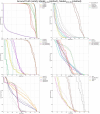Adaptive radiotherapy dose prediction on head and neck cancer patients with a 3D multi-headed U-Net deep learning architecture
- PMID: 40917990
- PMCID: PMC12412777
- DOI: 10.1088/3049-477X/adfade
Adaptive radiotherapy dose prediction on head and neck cancer patients with a 3D multi-headed U-Net deep learning architecture
Abstract
Online adaptive radiation therapy (ART) personalizes treatment plans by accounting for daily anatomical changes, requiring workflows distinct from conventional radiotherapy. Deep learning-based dose prediction models can enhance treatment planning efficiency by rapidly generating accuracy dose distributions, reducing manual trial-and-error and accelerating the overall workflow; however, most existing approaches overlook critical pre-treatment plan information-specifically, physician-defined clinical objectives tailored to individual patients. To address this limitation, we introduce the multi-headed U-Net (MHU-Net), a novel architecture that explicitly incorporates physician intent from pre-treatment plans to improve dose prediction accuracy in adaptive head and neck cancer treatments. Our dataset comprised 43 patients, each with pre-treatment plans, adaptive treatment plans, structure sets, and CT images. MHU-Net builds upon the widely adopted Stander U-Net architecture, extending it with a dual-head design: the primary head processes adaptive session contours and their corresponding signed distance maps, while the secondary head integrates pre-treatment contours, signed distance maps, and dose distributions. The features are merged within a primary U-Net framework to enhance dose prediction accuracy for adaptive treatment sessions. To evaluate the effectiveness of MHU-Net, we conducted a comparative analysis against U-Net. On average, MHU-Net reduced organ-at-risk dose prediction errors, achieving 1.78% lower maximum dose error and 1.22% lower mean dose error compared to U-Net. For the planning target volume, MHU-Net demonstrated significantly improved accuracy, with maximum and mean dose errors of 3.54 ± 2.75% and 1.07 ± 0.88%, respectively, outperforming U-Net's corresponding errors of 5.36 ± 4.19% and 2.76 ± 2.22% (P < 0.05). Taken together, these findings demonstrate that the proposed MHU-Met advances DL-based dose prediction for ART by effectively integrating both pre-treatment and adaptive session data. This approach facilitates the generation of dose distributions that more closely resemble the clinical ground truth, supporting personalization in ART planning and improving alignment with physician intent and treatment objectives.
Keywords: adaptive radiation therapy; artificial intelligence; dose prediction; head and neck cancer.
© 2025 The Author(s). Published by IOP Publishing Ltd.
Conflict of interest statement
No conflicts of interest.
Figures





References
LinkOut - more resources
Full Text Sources
Miscellaneous
